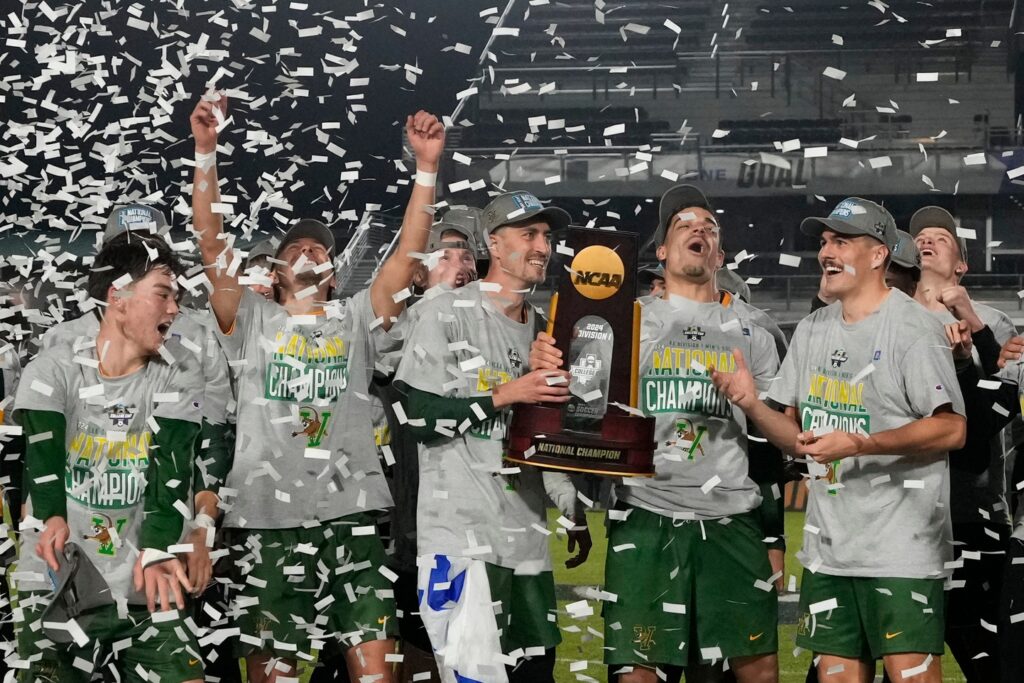In an era defined by rapid tactical innovations and a relentless pursuit of excellence, modern football clubs continually seek new ways to optimize performance both on and off the pitch. A potent source of inspiration lies not within the boundaries of professional leagues but in the time-honored traditions of American college sports.
Often characterized by an exceptional sense of unity and deep-rooted camaraderie, the sisterhood and brotherhood culture that thrives in collegiate settings offers valuable lessons in resilience, collective accountability, and personal development.
As clubs in Europe, MLS, and beyond look to refine their identities and cultivate environments that foster lasting bonds, there is much to be learned from the educational and athletic systems where players first learn the art of teamwork.
College sports, particularly American football and soccer, are steeped in rituals, shared experiences, and a commitment to a larger collective mission. These elements not only translate into impressive on-field performances but also contribute to a durable identity that carries players well into their professional careers. The ethos of brotherhood in these programs is not merely about winning games – it is about building a support system where every member feels valued, respected, and driven to push beyond personal limitations. The resulting dynamic often serves as a powerful counterpoint to the highly individualistic pressures inherent in professional sports today.
The Essence of Brotherhood in College Sports
Central to the success of college sports programs is the unyielding commitment to creating an environment where trust and mutual respect reign supreme. Within many collegiate teams, the concept of brotherhood transcends the typical coach-player relationship, evolving into a network of mentors, peers, and lifelong friends who collectively navigate the adversities of competitive sports. This intangible yet powerful bond not only propels teams to excel on the field but also shapes the individuals long after they have finished their collegiate careers.
A vivid illustration of this phenomenon can be found through narratives that celebrate the enduring impact of strong team cultures. For instance, an in-depth reflection on the experiences of a renowned player offers insights into how the brotherhood culture in college football programs like Ohio State or at Indiana University in soccer, ingrains values such as loyalty, perseverance, and a shared sense of destiny. The story vividly demonstrates how the rigors of practice, the weight of collective expectations, and the celebrations of victory coalesce to form a bond that can define a generation.
This deeply rooted sense of unity is cultivated through an emphasis on accountability. In many college programs, victories and defeats are experienced as communal events rather than isolated incidents. The shared responsibility for a team’s outcome creates an environment where every individual is motivated to contribute to the success of the group. Over time, this sustained commitment fosters a culture of excellence that professional clubs are increasingly eager to emulate.

Translating College Brotherhood into Club Dynamics
The principles that underscore the brotherhood culture in college sports have clear implications for the professional game. Football clubs around the world can benefit by embracing elements of this culture, from instilling stronger social bonds among players to emphasizing collective achievements over individual accolades. A unified team is more resilient, better able to weather the highs and lows of a season, and often exhibits a higher degree of tactical cohesion on the field.
Recent research underscores the impact of a well-integrated support system on team performance. For example, findings published by the NCAA highlight that when players operate within an environment of mutual accountability and encouragement, their confidence surges, leading to improved overall performance. This trend is evident not only in collegiate sports but also in elite professional settings, where an ingrained spirit of togetherness often correlates with on-field success. Such insights suggest that adopting similar pathways can bolster team spirit and, ultimately, enhance competitive results.
Beyond performance metrics, the emotional intelligence nurtured in a collegiate setting prepares players for the inevitable challenges of professional sports. When individual egos are tempered by the desire to belong and to contribute to a collective mission, clubs can witness a transformation in their internal dynamics. This mindset shift encourages players to invest in one another, fostering an atmosphere where skills are honed through shared practice sessions and mutual mentoring. The resultant effect is a team that is not only tactically proficient but also psychologically resilient – a fundamental ingredient for long-term success.
The Role of Leadership and Mentorship in Building Cohesion
Effective leadership is the cornerstone of any thriving team culture. On college campuses, coaches and senior players often serve as both mentors and role models – a dual role that helps instill discipline and a strong collective identity among emerging talents. By fostering an environment where each member is encouraged to lead by example, coaches in college sports create a ripple effect of empowerment that can be mirrored in professional clubs.
Modern football managers and technical directors are increasingly recognizing that tactical innovation alone is insufficient to secure consistent victories. Instead, it is the quality of interpersonal relationships – built on trust and a shared vision – that often determines the outcome of critical matches. Data from McKinsey reinforces this perspective, revealing that organizations with cohesive and supportive team dynamics tend to achieve higher performance levels. This research suggests that investing in leadership development and nurturing close-knit relationships among players can yield substantial dividends on the pitch.
In professional clubs, establishing a mentoring system similar to that found in college sports could help less experienced players integrate more smoothly into the first team. Veterans who have experienced the full spectrum of high-pressure football can pass on not only technical knowledge but also the mental fortitude necessary to overcome setbacks. Such an approach not only strengthens the immediate tactical unit but also contributes to a lasting legacy of collective resilience and adaptability.
A Comparative Look at Club Culture in Soccer and American College Systems
While the ideals of brotherhood and collective identity are universally admired, the operational environments of college sports and professional club football differ markedly. In the collegiate arena, the relatively transient nature of teams – where players remain only for a limited number of years – intensifies the focus on using every moment to build robust interpersonal connections. Conversely, professional clubs often operate with longer-term contracts and greater market pressures, which can sometimes undercut the development of deeply personal bonds.
Despite these differences, there are visible efforts among many clubs – especially within leagues like MLS and top European competitions – to replicate a collegiate-style ethos. Tactical evolutions in modern football increasingly emphasize collective movement, shared responsibilities, and fluid communication channels. A review of recent trends as discussed on MLS top performances reveals that teams which cultivate an atmosphere of mutual respect and relentless support often outperform their rivals, both statistically and in key match moments.
This convergence of philosophies highlights a natural evolution within the sport. As clubs adopt more holistic approaches to player development, the emphasis shifts from individual brilliance to a more balanced team performance. This transition is particularly visible in training regimens that prioritize group drills, team-building exercises, and structured mentorship programs. The success of these initiatives underscores the potential benefits of integrating elements of college-style brotherhood into the fabric of professional football.
Moreover, the success of the American collegiate system in fostering tight bonds between players offers an interesting case study for clubs grappling with the complexities of modern football. In a sport where player transfers and short-term contracts are common, creating a resilient internal culture is paramount. By investing in long-term relationships and emphasizing the importance of trust and unity, clubs can address challenges such as locker room conflicts and performance inconsistencies, ultimately paving the way for sustained success.
Embracing Team Dynamics for Future Success
As football continues to evolve, the ability to adapt team dynamics to contemporary challenges becomes increasingly critical. Embracing the lessons of brotherhood from American college sports can usher in a new era where clubs invest not just in star talent but also in comprehensive, relationship-driven development. This holistic approach involves recognizing that every member of the team, from the youngest prospect to the most seasoned veteran, plays a crucial role in the collective journey.
In practical terms, clubs can integrate structured off-field activities – ranging from team retreats to communal training camps – that emphasize bonding and shared experiences. These initiatives help build a repository of positive memories and mutual respect that players can draw on during difficult periods. As players transition through various phases of their careers, such cohesion can provide a stabilizing influence, reducing internal friction and reinforcing a shared commitment to excellence.
Additionally, embracing innovative communication frameworks that encourage openness and transparency can further strengthen team bonds. Regular feedback sessions, cross-functional training programs, and even psychological support systems can bridge the gap between individual ambition and group achievement. The ultimate outcome is a team where personal success is intertwined with a collective vision, rendering each victory – and even each setback – a shared experience.
This integrative approach not only benefits on-field performance but also contributes to the sustainable growth of clubs. In an era of heightened media scrutiny and commercial pressures, internal solidarity becomes a valuable buffer against external challenges. By cultivating a culture where every player feels integral to the team’s success, football clubs can enhance morale, reduce turnover, and foster an environment that attracts talent committed to long-term goals.
The organizational benefits of such a strategy are increasingly evident across multiple sports. As clubs continue to challenge conventional paradigms of competition, the adoption of team-centric practices – comparable to those seen in American college systems – may well become the new norm. This cultural shift represents not only an evolution in training methodologies but also a reimagining of what it means to be a part of a truly unified team.
Conclusion
The lessons drawn from the brotherhood culture in American college sports are both insightful and transformative. Through the nurturing of trust, resilient leadership, and collective accountability, college programs have set a benchmark that professional football clubs can aspire to. While the environments of collegiate and professional sports differ considerably, the underlying principles of unity, mentorship, and shared purpose remain universally relevant.
By adopting a multifaceted approach that places equal value on interpersonal bonds and tactical discipline, football clubs can unlock new levels of performance and stability. In today’s fast-paced sporting landscape, integrating these timeless values offers a pathway to create teams that are not only tactically adept but also emotionally resilient. Such an evolution requires a commitment to long-term development and an acknowledgment that true success is built on the strength of collective identity.
As the sport of football continues its global evolution, the fusion of academic insights from college sports with modern professional practices will likely redefine team culture in the coming decades. Ultimately, the journey to sustained excellence lies in embracing a model where each victory is the result of coordinated teamwork and unwavering mutual support.
Through this lens, modern football clubs may very well find that the secret to enduring success – and the spark that ignites unparalleled performance – is rooted in the very principles that have long defined the spirit of American collegiate sports.
Main photo credit: © Bob Donnan-Imagn Images




